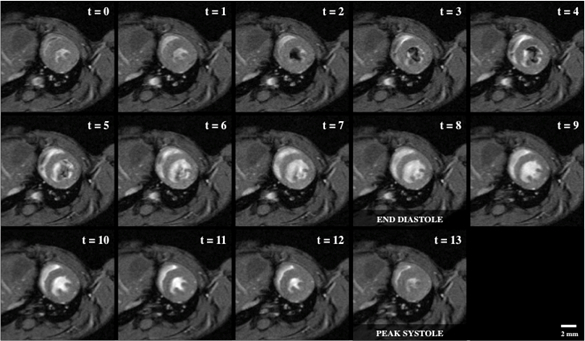心脏磁共振成像
Overview
资料来源:弗雷德里克·达门和克雷格·戈尔根,珀杜大学韦尔登生物医学工程学院,西拉斐特,印第安纳州
在本视频中,通过生理监测,演示了高场、小孔磁共振成像(MRI),以获取鼠心血管系统的门控膜环。此过程为评估左心室功能、可视化血管网络和量化因呼吸引起的器官运动提供了基础。类似的小型动物心血管成像模式包括高频超声和微计算机断层扫描(CT);但是,每种模式都与应考虑的权衡相关。虽然超声波确实提供高空间和时间分辨率,但成像伪像很常见。例如,密集组织(即胸骨和肋骨)可以限制成像穿透深度,而气体和液体(即肺周围的胸膜)之间的超呼信号可以模糊附近组织的对比度。相比之下,微CT不会遭受尽可能多的平面内伪影,但具有较低的时间分辨率和有限的软组织对比度。此外,微型CT使用X射线辐射,并经常要求使用造影剂来可视化血管,这两种物质已知在高剂量下造成副作用,包括辐射损伤和肾损伤。心血管MRI通过否定电离辐射的需要和为用户提供无反光剂成像的能力(尽管造影剂常用于MRI),在这些技术之间提供了很好的折衷。
这些数据是通过触发快速低角度热(FLASH)MRI序列获得的,该序列在心脏周期的R峰和呼吸中的呼气中呼退的高原上被封闭。这些生理事件通过皮下电极和固定在腹部的压力敏感枕头进行监测。为确保鼠标正确加热,插入了直肠温度探头,用于控制 MRI 安全加热风扇的输出。一旦动物入 MRI 扫描仪的孔和导航序列运行以确认定位,门控 FLASH 成像平面被规定和获取数据。总体而言,高场核磁共振成像是一种强大的研究工具,可以为研究小动物疾病模型提供软组织对比。
Procedure
1. 动物准备
- 识别在笼子里成像的小鼠并将其转移到麻醉感应室。
- 使用除胶对鼠标进行麻醉,并使用脚趾捏技术确认击倒。抓住拇指和食指之间的爪子,用力捏住以检查反应。如果动物收回他们的脚,你应该等待或重新剂量与麻醉根据批准的协议。
- 检查所有进入成像设施的员工都 MR 安全。这包括去除任何磁性服装/配件,确认没有磁性植入物或心脏起搏器,以及去除含有穿孔的金属。
- 打开的分明流到MRI室的诺塞酮。这允许在小鼠转移前用麻醉剂注洗较长的管子,以确保动物不会醒来。
- 关闭离室流到麻醉感应室,并将小鼠转移到成像阶段。将鼠标放在舞台上,使心脏的大致位置与磁铁的中心对齐。
- 固定鼻锥,并使用脚趾捏技术重新确认击倒。
- 将三个心电图导线插入下皮,一条通向心脏的左右,一条位于左后肢底部。
- 使用无菌探头护套和润滑剂插入直肠温度探头。
- 将枕头呼吸传感器放在腹部的胃部区域,并用纸板将其固定到位。纸板将确保压力敏感信号。
- 确认所有生理信号都是通过扫描仪室外的监控软件获取的。如果检测
Results
Application and Summary
Tags
跳至...
此集合中的视频:

Now Playing
心脏磁共振成像
Biomedical Engineering
14.8K Views

使用光学和共聚焦显微镜成像生物样本
Biomedical Engineering
35.8K Views

生物样品的SEM成像
Biomedical Engineering
23.8K Views

纳米药物载体的生物分布:SEM的应用
Biomedical Engineering
9.3K Views

腹大塔的高频超声成像
Biomedical Engineering
14.6K Views

腹部主动脉瘤的定量应变图谱
Biomedical Engineering
4.6K Views

红外主塔中图像血液和脂质的光声断层扫描
Biomedical Engineering
5.7K Views

脑动脉瘤血流的计算流体动力学模拟
Biomedical Engineering
11.8K Views

腹主动脉瘤的近红外荧光成像
Biomedical Engineering
8.3K Views

非侵入性血压测量技术
Biomedical Engineering
11.9K Views

心电图(心电图)信号的采集与分析
Biomedical Engineering
106.1K Views

可吸收生物材料的拉伸强度
Biomedical Engineering
7.5K Views

小鼠脊髓的微CT成像
Biomedical Engineering
8.0K Views

大鼠非侵入性ACL损伤后膝关节退化的可视化
Biomedical Engineering
8.2K Views

结合 SPECT 和 CT 成像,使心脏功能可视化
Biomedical Engineering
11.0K Views
版权所属 © 2025 MyJoVE 公司版权所有,本公司不涉及任何医疗业务和医疗服务。
